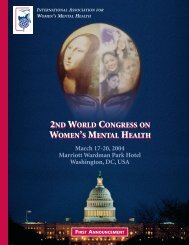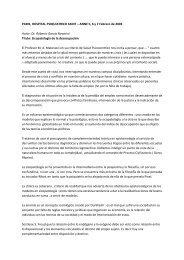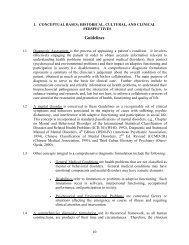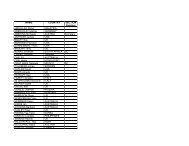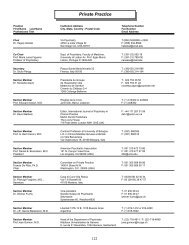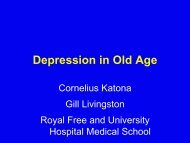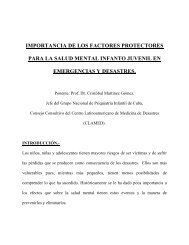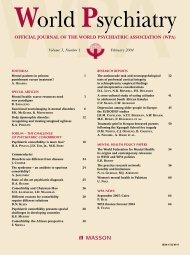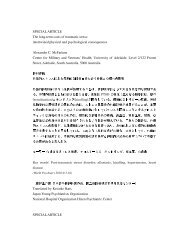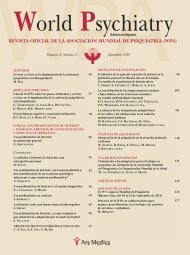ABSTRACTS - World Psychiatric Association
ABSTRACTS - World Psychiatric Association
ABSTRACTS - World Psychiatric Association
Create successful ePaper yourself
Turn your PDF publications into a flip-book with our unique Google optimized e-Paper software.
also shown. The optimal cut-off point was estimated as 5/6, and the<br />
sensitivity and specificity were 0.94 and 0.93, respectively. The ROC<br />
curve analysis indicated that the diagnostic efficiency of MIS-K was<br />
comparable with that of MMSE-KC. We conclude that the MIS-K has<br />
not only high reliability and validity, but is also useful as a screening<br />
instrument for dementia.<br />
PO3.104.<br />
PATTERN OF CEREBRAL ANOMALIES IN OLDER<br />
PERSONS WITH SCHIZOPHRENIA OR ALZHEIMER’S<br />
DISEASE<br />
M. Boccardi, D. Paternicò, A. Prestia, C. Geroldi, A. Adorni,<br />
G.B. Frisoni<br />
IRCCS S.Giovanni di Dio, Fatebenefratelli, Brescia, and AFaR<br />
(Associazione Fatebenefratelli per la Ricerca), Rome, Italy<br />
Different cognitive impairment is described for people with Alzheimer’s<br />
disease (AD) and for elderly people with schizophrenia, but the differences<br />
in the patterns of cerebral anomalies at direct comparison of the<br />
two conditions is unknown. The study aimed to identify the differences<br />
in the grey (GM) and white matter (WM) of people with geriatric schizophrenia<br />
and AD with voxel-based morphometry (VBM). Twenty elderly<br />
subjects with schizophrenia (age: 67.7±6.2; sex: 10 females) from a<br />
psychogeriatric ward, 19 consecutive outpatients with AD (73.2±9.0; 12<br />
females) and 19 controls (73.1±7.3; 14 females) underwent high resolution<br />
3D magnetic resonance imaging. VBM was performed with SPM2,<br />
(optimized protocol). P was set at 0.05-FDR corrected for the comparisons<br />
with controls and at 0.005 uncorrected for direct comparisons of<br />
patient groups. Subjects with schizophrenia compared to controls had<br />
smaller GM in the thalamus, parahippocampal gyrus and putamen.<br />
Smaller clusters of atrophy were located in the cingulate, insular, frontal<br />
and occipital gyri. AD patients vs. controls had atrophy in the thalamus,<br />
medial frontal gyrus, and parietal lobe, extending to the cuneus and precuneus.<br />
On the direct comparison of schizophrenia vs. AD, a cluster of<br />
atrophy could be observed in the precuneus of AD patients. The WM<br />
experiment showed atrophy along the whole corpus callosum in schizophrenics<br />
vs. controls and, although to a lesser extent, in the AD sample<br />
vs. controls. On the direct comparison the schizophrenia sample<br />
exhibited smaller WM volume in the right cerebellum. Thus, the patterns<br />
of GM and WM anomalies were largely overlapping in schizophrenia<br />
and AD patients, but the two samples showed an opposite<br />
trend, with greater GM involvement in the AD sample, and more WM<br />
anomalies in the schizophrenia sample. This may reflect the different<br />
pathogenesis of the two conditions: degenerative in AD and developmental<br />
in schizophrenia.<br />
PO3.105.<br />
TREATMENT OF LATE LIFE DEPRESSION<br />
ASSOCIATED WITH MILD COGNITIVE IMPAIRMENT<br />
R.M. Chenderes, C. Mila, D.M. Podea, P.D. Nanu<br />
Departments of Psychiatry and Neurology, University of Arad,<br />
Romania<br />
The aim of this study was to determine the influence of mild cognitive<br />
impairment (MCI) on the outcome of late life depression. We recruited<br />
60 patients diagnosed with late life depression (ICD-10 and DSM-<br />
IV criteria, age over 65 years) and MCI (score between 21 and 28 on<br />
the Mini Mental State Examination, MMSE). The patients were divided<br />
into two groups: group A (30 patients treated with mirtazapine, 15-<br />
30 mg/day, and piracetamum, 1600 mg/day) and group B (30 patients<br />
treated with mirtazapine only) The evaluation was done at recruitment,<br />
after 6 weeks and after 6 months of treatment. Cognitive impairment<br />
was evaluated with the MMSE and depressive symptoms with<br />
the Montgomery-Asberg Depression Rating Scale (MADRS). The<br />
average of MMSE scores for group A were 26.3 at recruitment, 27.9<br />
after 6 weeks and 28.6 after 6 months. Group B improved by only 1.5<br />
points after 6 weeks (from 25.7 to 27.2) and by only 1.8 points after 6<br />
months (from 25.7 to 27.5). The improvement on the total MADRS<br />
score was 7.6 points for group A vs. 4.9 points for group B after 6<br />
weeks and 11.2 and 7.3 points, respectively, after 6 months. These<br />
data suggest that MCI has a better outcome in patients treated with<br />
antidepressants and nootropics than in those treated only with antidepressants.<br />
This work was supported by the Romanian Ministry of Education and<br />
Research.<br />
PO3.106.<br />
ANTIOXIDANTS ASSOCIATED WITH NOOTROPICS<br />
IMPROVE MILD COGNITIVE IMPAIRMENT<br />
IN A POPULATION OVER 65 YEARS OLD<br />
D.M. Podea, P.D. Nanu<br />
Departments of Psychiatry and Neurology, University of Arad,<br />
Romania<br />
With aging, oxidative stress may cause mild cognitive impairment<br />
(MCI). We evaluated the improvement of cognitive functions using<br />
nootropics alone or nootropics associated with antioxidants in a late<br />
life population with MCI. We included 60 patients with MCI (Mini<br />
Mental State Examination, MMSE score between 21 and 28), over 65<br />
years of age. They were divided into two groups: group A (n=30) treated<br />
with piracetam (1600 mg/day); group B (n=30) treated with coenzyme<br />
Q10 (30 mg/day) plus piracetam (1600 mg/day). They were evaluated<br />
using MMSE at admission, and after 1, 3 and 6 months of treatment.<br />
After 1 month of treatment, the mean MMSE score improved by<br />
0.2 points in group A and 0.4 points in group B. After 6 months of<br />
treatment, those treated with piracetamum+CoQ10 had an increase in<br />
the MMSE median score of 3.3 points, vs. 1.3 points in group A. The<br />
association of piracetam and CoQ10 may improve the cognitive functioning<br />
by several mechanisms: the reduction of inflammation, excitotoxicity<br />
and oxidative stress, or the triggering of axonal/dendritic<br />
sprouting.<br />
The work was supported by the Romanian Ministry of Education and<br />
Research.<br />
PO3.107.<br />
CONCEPT OF DEPRESSION-DEMENTIA<br />
INTERMEDIATE ZONE<br />
T. Kobayashi, S. Kato<br />
Department of Psychiatry, Jichi Medical University, Tochigi, Japan<br />
In this rapidly aging society, clinicians are faced with more and more<br />
mentally disordered elderly people. Among mental disorders in the<br />
elderly, depression and dementia are the most common in clinical<br />
practice. However, both sometimes coexist, succeed each other, and<br />
confuse clinicians. It has been argued that depression can be distinguished<br />
from apathy in dementia by its emotional responses expressed<br />
as negative thought about self, present, and future, despair, helplessness,<br />
and pessimism. It has been pointed out that depressive symptoms<br />
such as sadness, diurnal variation in mood, early and late insomnia<br />
allow to differentiate major depression from Alzheimer’s disease.<br />
However, the distinction is not always so clear in clinical situations.<br />
Our clinical experience with patients who develop dementia after the<br />
277



